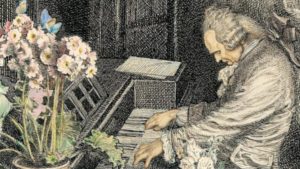Society’s 70th Anniversary Concert – Haydn’s Creation, 30th March 2019
A Saturday evening concert in Sunderland Minster starting at 7.30 p.m., conducted by David Murray.
 This will be the Society’s 70th Anniversary concert and will replicate its first concert with a performance of Haydn’s ‘Creation’.
This will be the Society’s 70th Anniversary concert and will replicate its first concert with a performance of Haydn’s ‘Creation’.
Soloists : Laurie Ashworth – soprano, Jorge Navarro Colorado – tenor, and Timothy Dickinson – bass baritone.
Tickets £14.00 for Nave (£8 concessions for full-time students and on income related benefits) or £8.00 (Gallery – limited view). Accompanied under 16s free. Tickets are available from members of the Society, at the door, or on-line from http://www.wegottickets.com/BCS – who also have a direct link on the home page of this website. Doors open from 6.45 p.m.
 It was Haydn’s encounter with Handel’s oratorios in London that sowed the seeds of his most famous and enduring masterpiece:The Creation. At the 1791 Handel Festival in Westminster Abbey he was overwhelmed by the monumental sublimity of the choruses in Handel’s Messiah and Israel in Egypt, performed by a gargantuan array of over 1000 players and singers.
It was Haydn’s encounter with Handel’s oratorios in London that sowed the seeds of his most famous and enduring masterpiece:The Creation. At the 1791 Handel Festival in Westminster Abbey he was overwhelmed by the monumental sublimity of the choruses in Handel’s Messiah and Israel in Egypt, performed by a gargantuan array of over 1000 players and singers.
While still in London Haydn expressed a desire to compose a work on a similarly exalted biblical theme that would appeal to a broad public. For the time being nothing came of the idea, but just before he left England for the last time, in the summer of 1795, the impresario and violinist Johann Peter Salomon handed him an anonymous English libretto on the subject of The Creation which had allegedly been intended for Handel half a century earlier.
Haydn immediately saw the musical potential in The Creation text, whose main sources were the book of Genesis, Milton’s Paradise Lost (especially for the animal descriptions in Part Two, and the hymn and love duet in Part Three) and, for several of the choruses of praise, the book of Psalms.
Back in Vienna, the composer asked the Imperial Court Librarian, the formidable Baron Gottfried van Swieten, for his opinion. In Swieten’s own words, ‘I recognized at once that so elevated a subject would give Haydn the opportunity…to express the full power of his inexhaustible genius; I therefore encouraged him to take the work in hand….’ Swieten made a highly skilled job of translating and adapting the libretto,.
The structure of The Creation has an ideal simplicity and strength. The first of the oratorio’s three parts begins with “Representation of Chaos”, an orchestral prelude that uses stark chords and shifting harmonies to portray the formlessness and disorder that preceded the Creation. The six days of creation are each introduced in recitative by the archangels Raphael (bass), Uriel (tenor) and Gabriel (soprano). Each new creation – light, water, landscapes, plants, and beasts of land and sea and air – is depicted with lavish tone painting. The story of Adam and Eve begins in the third part, and focuses on the happy union between Adam and Eve, culminating in a tender marriage duet
The Creation received immediate acclaim when it was performed before a packed aristocratic audience in the Schwarzenberg Palace in Vienna, first at an open rehearsal on 29 April 1798 and then at its official premiere the following day. Haydn, who conducted, was as overwhelmed as his listeners.
Replying to a letter expressing admiration for The Creation, Haydn wrote in 1802 that ‘Often, when I was struggling with all kinds of obstacles… a secret voice whispered to me: “There are so few happy and contented people in this world; sorrow and grief follow them everywhere; perhaps your labour will become a source from which the careworn… will for a while derive peace and refreshment.”’ These words are typical of a devout, humble yet by no means naive man. Haydn’s hopes were richly fulfilled in his lifetime. In our own sceptical and precarious age we can still delight, perhaps with a touch of nostalgia, in Haydn’s unsullied optimism, expressed in some of the most lovable and life-affirming music ever composed.
The end result was the greatest triumph of Haydn’s career.




